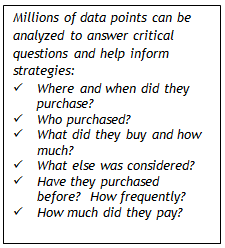By Laura Iles - Sr. Consultant, Integrated Insight
As I watch the ads this season, I’m reminded that loss
leader strategies are a favorite holiday pricing tactic of the various
establishments competing for our dollars. When used appropriately, discounting
below cost can be a useful strategy for pulling repeat customers in the door, driving
incremental sales, and establishing new clients. But this strategy is not
appropriate for every business, nor for every occasion. Below, we’ll look at
some of the critical factors to consider in determining whether this particular
pricing tactic will achieve your goals.
Attracting the Right
Customers
The first question is whether a loss leader strategy will
attract the kind of customers that will remain with the company long term.
While steep discounts can entice new customers with a low-risk chance to sample
offerings, there is always the chance of drawing individuals who cannot afford
to pay full price for the products / services once the offer is concluded, and
have no intention of making incremental purchases on that first visit.
This is where market research becomes critical.
Understanding existing customers and their motivations will enable the firm to
decide whether a discount message of this level will be attractive. Price is
not the only loyalty driver – Nielsen research demonstrates that globally, 59% of customers would be most enticed to switch
brands, service providers, or retailers for an attribute other than price. Clearly, a dramatic savings message is not the
only way to attract customers.
Maintaining the
Customer Experience
Prior to execution, consider whether resources exist to
manage the volume increases. Depending on how valuable the offer is perceived
to be, the deal may end up attracting more customers than the firm is prepared
to handle. A sudden spike in online traffic can crash servers and attendance
increases may overwhelm stores. Consider whether a more modest savings message
would be effective, while helping to preserve the customer experience.
Limitations
Specific limits around the campaign will help to prevent a
devaluation of what current customers have already purchased. Loss leaders for
specific times (Black Friday) or specific subsets of customers (local
residents, particular email lists, etc.) will help to prevent a general
weakening of your brand image, as well as shielding the firm from widespread
losses if the strategy does not produce incremental sales. As time passes, it
is useful to periodically review limitations for any ongoing loss leaders.
There is always the hazard of training your customers to wait for discounts if
such messages are provided too frequently.
Imaging
Think long term – does this tactic support the firm’s
overall image? The danger with any loss leader strategy is the risk of creating
a “discount” image. Many businesses utilize this approach successfully, just
make sure it’s the most appropriate one for the company. Fencing the offers (e.g.
limited time only, a subset of individuals only) will help to mitigate the
discount appearance and retain value for the firm.
Create an Exit
Strategy
As with any new strategic plan, be willing to utilize an
exit strategy if the loss leader tactic is not creating the anticipated level
of success. Develop guidelines around targets and time frames before implementation
and establish metrics to use in evaluating success. You might cross-track
elasticities to measure the impact a loss leader has on sales of additional
items, as well as establish a process for tracking new customer retention. Discount
messaging is an easy way to drive immediate sales, but determining whether it creates
long-term profitability requires tracking the results.
Using a loss leader to drive penetration can be powerful,
but it’s not the only pricing tactic available. Make sure it truly aligns with the
company’s strategy and the customer’s needs before deciding which course to
pursue.

